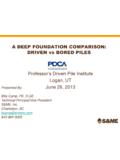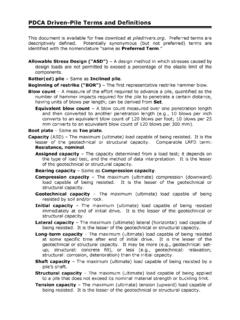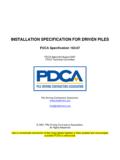Transcription of Dynamic Pile Testing - Pile Driving Contractors …
1 1 Dynamic pile TestingASTM D4945 pile Driving Analyzer Dynamic pile TestingASTM D4945 pile Driving Analyzer Garland Likins, pile dynamics , PDCA Professor s InstituteGarland Likins, pile dynamics , PDCA Professor s InstitutePublic assured of safe foundation (bridges, buildings, etc.)We spend lots of money - $4B. Remediation is very expensive !Reduce the risk Optimize foundation -reduce costWhy test driven piles?Driven piles are tested more often than any other foundationMore safe, less risk, less costStatic Analysis Methods Residual (saprolitic) granite soils: fine to medium silty sand with low plasticityInternational Prediction Event Behaviour of Bored, CFA, and Driven Piles in Residual Soil , ISC 2 Experimental Site, 2003, by Viana da Fonseca and Santos 2QA Inspection: Piles always have a blow count criteriaQA Inspection.
2 Piles always have a blow count criteriaWave Equation AnalysisWave Equation AnalysisBut wave equation contains assumptions of hammer performance & Dynamic soil behaviorMotion is measured by accelerometersstraingageF(t)acceleromete rv(t) Dynamic pile TestingDynamic pile TestingLoad is appliedby impacting ramLoad is measured bystrain transducersMeasurements are better than assumptions3 Convert STRAIN ( )to FF (t) = E A (t)Convert ACCELERATION to VV (t) = a(t) dtDynamic Testing on all driven pile typesSTRAINACCELERATIONGRL 40 ton APPLET esting an 84 drilled shaft, 30 drop hydraulic releaseActivated 4000+ tonsMeasure Strain and AccelerationConvert strain to forceIntegrate acc to velocity4average strains and velocities (plot proportionally by EA/c)Expand time scale scaleCalculate wave-up; integrate vel.
3 To displacement2L/c2L/crisepeakStrain to Force requires knowing Modulus Elastic Modulus for concrete pile (length L) is determined from concrete wavespeed, cc = 2L / T = (2)(75) = 12,500 ft/sE = c2 = (12,500)2 { ( ) } = 729,000 k/ftft2(ft2/s2) (kips/ft3)/(ft/s2)E= 729,000/144 = 5,060 ksi2L/cGiven: 2L/c= 12 ms= T L = 75 ftCalculate E5 Attach sensors to pile prior to lofting pile Rigid foam Sensor Protectors Concrete pile testingwireless PDA smart sensors know their calibration6 PileSite APileSite BPile Driving Analyzer Internet connectionExperienced Engineer controls PDA as if on-site; monitors pile in real time with greatly reduced Testing available immediately to keep project on same dayOfficeSiteLink -Remote PDA USA Patent #6,301,551 Dynamic pile Monitoring pile integrity pile stresses Hammer performanceLast three items detect or prevent problems for driven pilesFor each blow determine Capacity at time of Testing Energy transferred to pile is equal to work doneE = F du E(t) = F(t) v(t) dtEnergy transferred to pile is equal to work doneE = F du E(t) = F(t) v(t) dt MaxRebound (energy returned to hammer) MaxRebound (energy returned to hammer)
4 F+V+F+V-7 Net measured energy transfer (steel piles)Net measured energy transfer (steel piles)0%20%40%60%80%100%20%80%cabled drop hammers60%30%diesel hammers40%70%air hammers60%100%hydraulic drop hammersEfficiencies on concrete piles are lower ~ 10%Hammer Performance is Performance is Contractor productivity To install pile to design depth Confirms assumptions Test device, quality controlPDA pile Stress MonitoringAssure Dynamic stresses during Driving remain below acceptable limits Average comp. stresses at sensor location Bending stresses at sensor location Tensile stresses in concrete piles Compressive stresses at pile bottomTo avoid pile damage adjust Driving system if needed8 FMX, CSXS train transducerForce (Stress) Maximum at gage locationFMX = avE A ; CSX = avEFMX: Ensure that sufficient force is applied to mobilize resistanceCSX: Ensure safe pile top stress compare with stress limitsCSI is highest individual strain readingPDA Testing - data acquisitionAverage force is proportional and reasonable; 2 sensors required to compensate bendingLocal stress 352 MPa; >50 ksiAverage stress 224 MPa.
5 ~32 ksiLarge bending present Hammer- pile alignment issue9 Compression force at toe2L/ct = 0L/cLAny downward compression force before t=2L/c will combine with the upward travelling wave reflected at L/c and received at top at 2L/cUpward WaveDownward WaveResistance/Force at Bottom, CFBC omputed Force at pile Bottom:CFB = Rtoe= Fd,1 + Fu,2 Rshaft Rshaft- discussed later Search over time for max value For pure end bearing pile :CFB = Fd,1 + Fu,2= RTL Computed Stress at pile BottomCSB = CFB / AAssumes stress is uniform over section CSX@T1 593 = RX5 = x FT1 CSB = x CSX@T110 Tension force at any location2L/ct = 0L/cLAny downward compression force before t=2L/c will combine with the upward travelling tension wave reflected at L/c and received at top at 2L/ctoptoeUpward WaveDownward WavePDA testingdata interpretationMax upward tension-1377 kNMin downward compression+786 kNHow do we calculate the maximum net tension force?
6 Maximum Net Tensionforce from superpositionof (a) maximum upward tension, and (b) minimum downward compression-1377 kN+786 kN-591 kNCodes: Allowable Driving StressesUSA (AASHTO) Steel piles90% of yield strength Fy Timber pilesSouthern Pine ksiDouglas ksi Concrete pilesCompression:(85% f c) - prestressTension :prestress + (50% of )prestress + 3 sqrt (f c) [f c in psi]11 pile Damage: BTA, LTD pile damage causes a tension reflection before 2L/c Time tension reflection arrives indicates depth to damage:LTD = tdamage* c / 2 Extent of damage is quantified by damage factor -BTA ()Reflection at an Impedance Change2L/ct = 0L/cZ2Fd2Fu1 Early Tension reflectionFd,12x/cZ1 ABFA= FBFd,1+ Fu,1= Fd,2vA= vBvd,1 + vu,1= vd,22ndequation:(Z1vd,1+ Z1vu,1) (Z2 /Z1) = Z2 vd,2define = Z2/Z1: ( Fd,1- Fu,1 )= Fd,2= ( Fd,1+ Fu,1) / ( Fd,1- Fu,1 )x= (Fd,1- + Fu,1)/(Fd,1 - Fu,1)(with shaft resistance) Fd,1= 4816 kNFu,1= -351 kNRx = 1237 * 2= 2474 = = +35112 Broken Piles.
7 < 60 End bearing is unreliable in long term for broken piles - Only shaft capacity above break might be useful usually minimal Capacity meaningless for broken piles BTA generally overestimates Z2 / Z1 real lower section generally less(%)Condition100 Uniform80 - 100 Slight damage60 - 80 Significant damage<60 BrokenCapacityCapacity At time of Testing vs depth during drive resistance distribution CAPWAP iCAP At time of Testing vs depth during drive resistance distribution CAPWAP iCAP 2L/ct = 0L/cLxRR- R- RRB RRBRBU pward traveling wave at time 2L/c:Fu,2= -Fd,1+ R + R + RBUpward traveling wave at time 2L/c:Fu,2= -Fd,1+ R + R + RBFd,1-Fd,1+ R+ Ror (rearranging)R = Fd,1+ Fu,2or (rearranging)R = Fd,1+ Fu,2 The Case Method EquationThe Case Method Equation13 The Case Method EquationThe Case Method Equation1122R = (F1+ Zv1+ F2- Zv2)F1and v1are pile top force and velocity at time 1F2and v2are pile top force and velocity at time 2 Time 2 is 2L/c after Time 1: t2= t1+ 2L/cF1and v1are pile top force and velocity at time 1F2and v2are pile top force and velocity at time 2 Time 2 is 2L/c after Time 1.
8 T2= t1+ 2L/cR is the total pile resistancepresent at the time of the test,and mobilized by the hammer Method Static ResistanceCase Method Static ResistanceTotal Resistance = Static + DynamicRd= Jvvtoe Vtoe= ( 2 WD1 - Rt ) / ZJc= JvZ Rd= JcZ vNon-dimensionalization leads to the Case Damping Factor, JcTo estimate Dynamic resistance, a viscous damping parameter ( Jv ) is introduced for multiplication of computed toe velocity vtoeRs= (1-Jc)[F1+ Zv1]/2 + (1+Jc)[F2- Zv2]/2Rs= (1-Jc) WD1+ (1+Jc) WU2 Case Method Static ResistanceCase Method Static ResistanceStatic = Total Resistance DynamicRstatic= R - Rdynamic14 Case Damping Factor Values for RMXCase Damping Factor Values for SizeReducingGrain SizeIncreasingDamping factorIncreasingDamping factorEasy drivingCase Method CapacityRS (t) = (1 - J) WD1 + (1 + J) WU2RS (t) = (1 - J) (FT1 + Z VT1) /2 + (1 + J) (FT2 - Z VT2) /2 Case Method CapacityRS (t) = (1 - J) WD1 + (1 + J) WU2RS (t) = (1 - J) (FT1 + Z VT1) /2 + (1 + J) (FT2 - Z VT2)
9 /2 Hard driving15 RMX method does a time searchRMX methods not as J sensitiveRMX methodRX5RP5Ri - Wave upR RMost Sites Have Set-up capacity gain with time after installation Most Sites Have Set-up capacity gain with time after installation Caused by reduced effective stresses in soil due to pile Driving (temporary) Pore pressure (clay - drainage log time) Arching(sand - lateral motions) Soil structure(cemented) Cookie cutters (oversize shoes ) Measure it by Dynamic Tests on Both End of Drive and Restrike (varied waits) Pre-Design Tests Early Production Piles1616 End of DriveRestrike (8 days)Low shaft resistanceIncreased shaft resistance(setup) Set-up End of Drive (EOD)Temporary stopBegin of Restrike (BOR)35 minutesIncrease in lower 1/3No tensionReports - ASTM D4945 Stop 35 min17 pile Setup - Side Shear18 PSC, O Cell at bottom Side in clay and silty clay in FL+30%+30%+30%= +90% in 1 day(or 9x EOD capacity)EOD Capacity plotted at ~1 minBullock, Schmertmann, McVay, Townsend.
10 Side Shear Setup , ASCE Geotechnical Journal March 20051-28d +43% about half ofEOD-1d , first one rare cases, the pile can lose capacity with & White, GRL EngineersIdentifying Soil Relaxation from Dynamic TestingOhio Turnpike (I80)Piles drive in clayey silt (N=30) to weathered siltstone/shale(N=50/1 )Pre-Construction Wave Equation Analysis suggests: 20 blows per inch ( mm set) at ft ( ) stroke at 300 tons18 P





